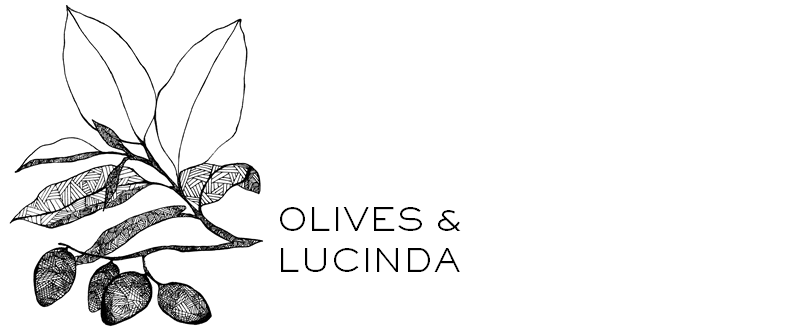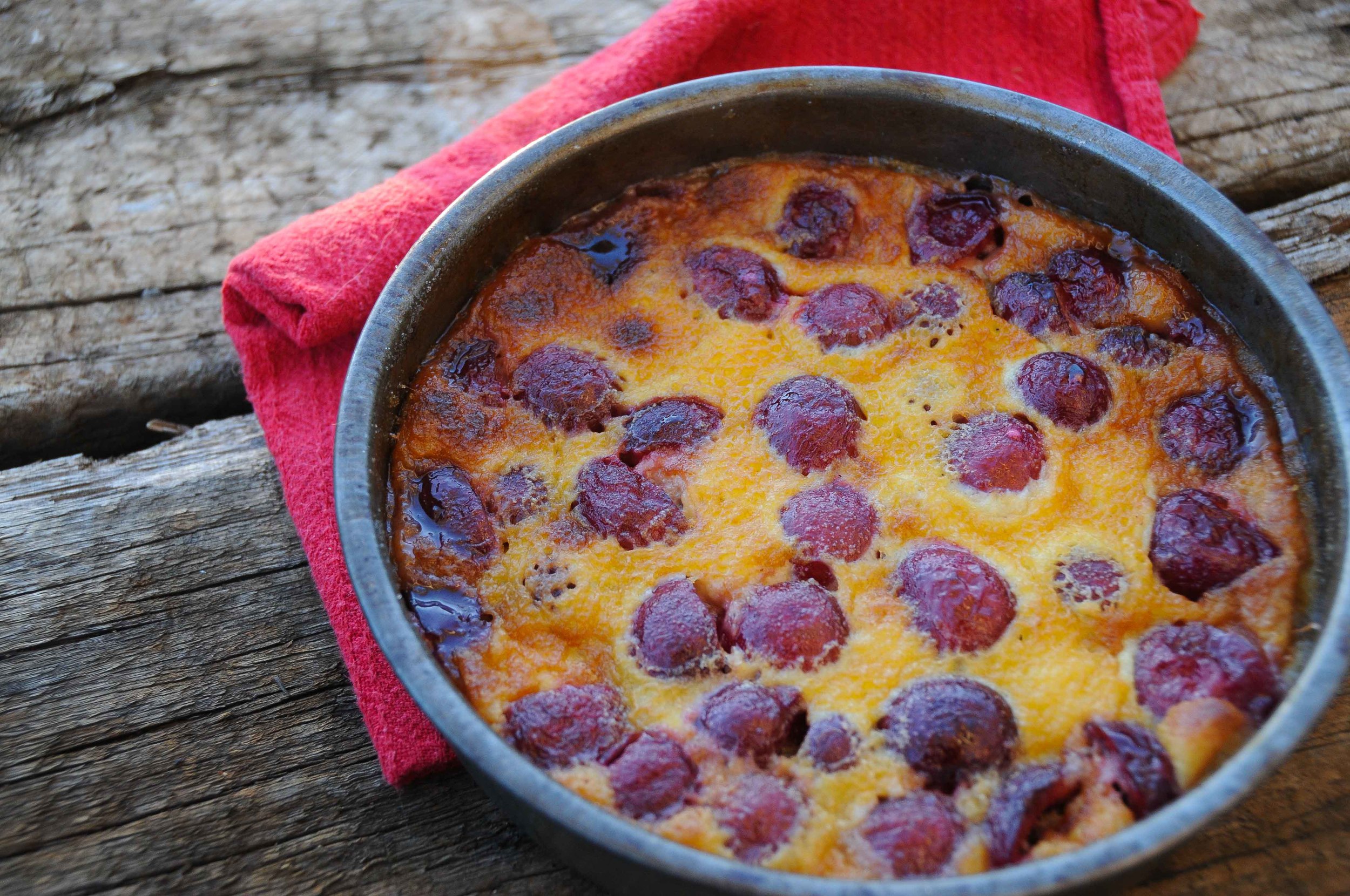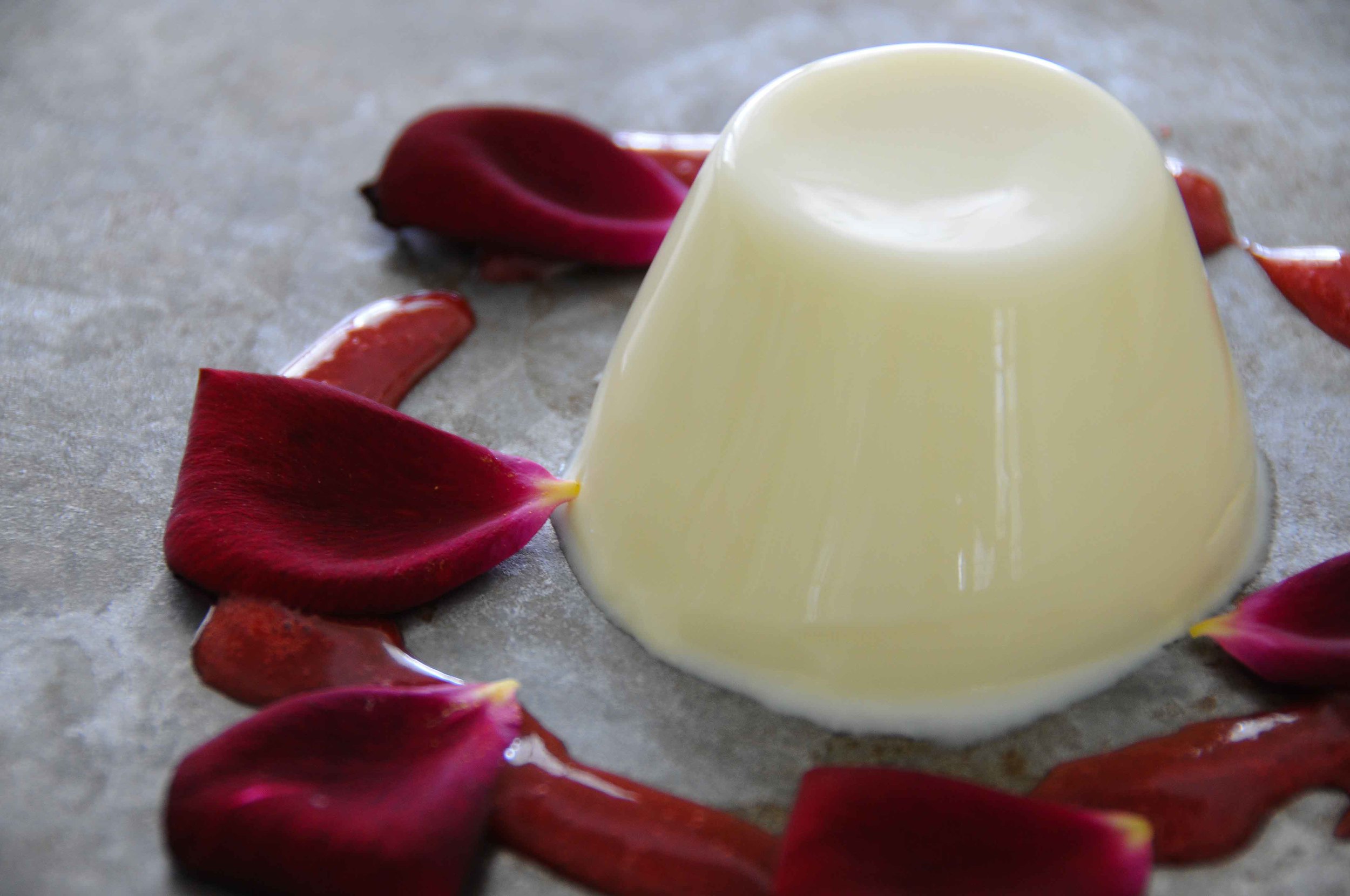Last time I wrote about travelling to our Coomboona farm, I likened the experience to Alice’s falling down the rabbit hole to Wonderland. I was speaking metaphorically of course, there was never actually any white rabbit, until this trip, when, in a strange instance of life intimating art, there suddenly was…
On one of the farm properties stands a little old house, surrounded by a once lovingly tended rose garden, planted in the 1950s. Beyond the garden, there is only open space, no other dwellings, just acres of fields stretching out flat into the distance. The house itself is no longer inhabited, but the roses are still going strong, growing a little more wild perhaps than they once were, but beautiful in bloom. I was in the garden this January, early one evening picking some rose petals with which to decorate the rosewater panna cotta pictured above, when suddenly I saw it. A flash of white moving fast out of the corner of my eye, then it stopped. Ears aloft and alert, just by the entrance to its burrow, sat a large white rabbit. For a while, I looked at it, and it looked at me. How had it gotten here, this domestic rabbit, miles from the nearest town? Then I reached for my camera and the spell was broken. The rabbit darted down the hole, and, in beginning another week in Coomboona, I tumbled straight down after it (metaphorically of course)!
I was excited to drive back to the Homestead and tell Mum about my sighting. ‘Yeh,’ she said in casual response, ‘there are actually two of them there.’ But then Mum has had some luck recently with fantastical sightings. A few months ago she told me she saw a full-grown stag on the shore of the lake in front of the house. Kangaroos, yes, often; some wild horses, very uncommon, but I’d believe it if told. But a stag? This is not the Scottish Highlands, and deer are not native to Australia, nor are they commonly farmed. I won’t say I didn’t believe Mum when she told me, because that is not strictly true. I will say though that, privately, I believed that there may have been alternative explanations for what she saw, fata morgana of the evening light playing tricks as it is shimmed off the surface of the water perhaps?
But then, on the final day of my stay, bumping along the dirt road in the 4WD, I spotted some unfamiliar shapes in one of our paddocks, distant in the high grass. I reached for the camera again, slowly this time, and zoomed in. (If I don’t start presenting some evidence sooner or later I thought, people are going to stop believing me). And there he was, antlers held high – and with a mate. It’s not a good photo, I apologise, but they were far away and I dared not get any closer fearing they’d run. How they got to be here in the first place, I don’t know, escapees from a faraway shopping mall Santa’s Grotto perhaps? Now that they are here though, I sincerely hope that they are comfortable and planning to stay.
The reason I am back in Coomboona this January has to do with a slightly more prosaic, but ultimately no less fantastical animal – the Holstein Dairy Cow. At the start of every year in this part of the world International Dairy Week comes to town, and with it, a plethora of milky, creamy, and occasionally cheesy on goings in celebration of the (not so) humble Holstein.
The most interesting of these are probably the cattle shows, where the cows and handlers are judged in catagories such as ‘etiquette,’ and ‘showmanship,’ as well as ‘clipping,’ ‘washing,’ and ‘feeding.’ Sadly though, I’ve been banned from saying anything else here about cattle showing for so-called ‘political reasons.’ What’s ‘political’ about cow beauty parades you might ask? Well, if you’ve ever watched the meticulous perming of a cow’s tail hairs, or met the people who are prepared to sleep in the pen beside the cow on the evening before a show in order that droppings may be immediately whisked away lest they sully a newly clipped and washed coat, you'd know better!
I saw action quite far back from the front lines this Dairy Week, in the Homestead kitchen. With no question as to what the star ingredients should be, it was simply a matter of concocting some recipes to best showcase the products of the local industry. So, butter, crème fraiche, and hard cheese in the risotto, and delicious whole milk and double cream for the rosewater panna cotta and custardy clafoutis. I also raided the vegetable garden for fresh seasonal ingredients – kale for the risotto, classic summer cherries for the clafoutis, and the secret garden source of my panna cotta rose petals, you know about already...
Curly Kale & Pancetta Risotto
It is quite fashionable at the moment to consume kale raw, blended with other green things into frankly scary looking smoothies. I wish I could get enthusiastic about this sort of thing, but sadly for me I am doomed to prefer it cooked along with much less virtuous things, such as pancetta, rice, cheese, and cream. I suggest not reading on if you are in the smoothy faction!
Ingredients
(Serves 4)
- 100g pancetta – cut into lardons (cubes)
- 200g curly kale
- 1 small brown onion – finely chopped
- ½ leek – finely chopped
- 1 stick of celery – very finely chopped
- 2 cloves garlic – crushed
- 2 small sprigs of rosemary – leaves finely chopped
- 50g butter
- 2 tablespoons olive oil ( + extra to drizzle)
- 225g risotto rice (Aborio or Carnaroli)
- 250ml dry white wine
- 1 litre of good quality vegetable stock
- Sea salt & pepper
- 2 tablespoons crème fraiche
- 50g Parmesan cheese – finely grated ( + some extra shaved flakes to serve)
- Juice of one lemon
Pour the vegetable stock into a saucepan and heat to a boil. Meanwhile, strip the tough central stalks from the kale and then roughly chops in to strips about 1cm wide. Blanch the kale in the hot stock for a few minutes, until tender, then remove using a slotted spoon to drain in a colander. Keep the stock warm over low heat on the stove top while you prepare the other ingredients.
Heat the butter and olive oil together over a medium-high flame in a large, heavy-bottomed pan. Add the lardons of pancetta and cook until they begin to brown. Now turn the heat to low and add the chopped onion, leeks, celery, and half the finely chopped rosemary. Soften these slowly without colouring, adding a little more olive oil if necessary and stirring occasionally to stop any sticking (approx. 10 minutes).
When the onions are almost done, add the crushed garlic and stir through. Cook for a further two minutes, before, turning the heat up a little and adding the risotto rice. Stir this around for a further 2 minutes or so until it begins to look translucent at the edges, then slosh in the wine. Stir vigorously until all the wine is absorbed, (a further couple of minutes), then begin to add the warm stock, ladle, by ladle, stirring with a wooden spoon as you go, and avoiding letting the risotto dry out.
To get a beautiful creamy texture, you need to coax the starch from the fat little rice grains, and this is achieved via stirring as the liquid is absorbed – so don’t skimp on the stirring. If you are not keen on the idea of being stationed by the pan for the next 30 minutes though, my advice would be to keep the risotto on the wet side using plenty of stock. If the risotto is dry and in danger of sticking, you will need to stir a lot soggier, and you can get away with a little more inattention.
About half way through the cooking time, at the 15 minute point, stir in the blanched kale along with a ladle-full of stock, and continue to stir.
When all the stock is absorbed, do a quick taste check – is the rice still uncooked in the middle? If so, keep adding stock or water until it is cooked through – still with some bite is good, but grainy and uncooked is not. The texture of the risotto should be loose and creamy at this point, soupy almost, and no longer really rice-like.
Also check the seasoning. Depending on the amount of salt contained in the pancetta and stock, the risotto may be salty enough, if not, add the appropriate amount here, keeping in mind that there is Parmesan still to add. A little grind of pepper will likely also be helpful.
When the rice is cooked, turn off the heat and immediately add the lemon juice, along with the crème fraiche, Parmesan cheese, and the remaining half of the chopped rosemary. Stir everything together and then pop a lid on the pan and let it stand for a minute.
To serve, ladle the creamy, kale-flecked risotto into shallow bowls, or on to plates. Top with a scattering of some extra shaved Parmesan if your like, and finish with a wide drizzle of extra virgin olive oil.
Summer Cherry Clafoutis
A clafoutis is a wonderful wobbly custard pudding. Originally from the Limosin region of France, it’s a great way to use up ripe summer fruit. Cherry clafoutis is the classic, and my favourite, but it can also work well with blueberries, or apricots.
Designed to be eaten warm, not hot, if you pop the clafoutis in the oven before you sit down to a summertime lunch, by the time you are ready to eat, it will be the perfect temperature. Serve with a little jug of cool cream alongside for maximum lactose intake!
Ingredients
(Serves 4)
- 400g cherries
- 20g salted butter (+ a little extra for greasing)
- 6 tablespoons caster sugar
- 2 large free range eggs
- 30g plain flour
- ½ teaspoon vanilla extract
- 60ml whole milk
- 75ml double cream (+100ml extra to serve)
You will need a shallow baking dish for this recipe - large enough to fit the cherries in one layer.
_ _ _
Begin a couple of hours ahead of time by halving and stoning the cherries. Place these in a bowl and cover with one tablespoon of the caster sugar. Set aside for 2 hours to macerate – this will help the intensify the flavour of the fruit. (If you are partial to alcohol in puddings, you might also sneak in a little Kirsch at this stage, but personally I prefer without).
Preheat the oven to 180°C and grease your baking dish with butter. Sprinkle one tablespoon of the sugar over the base of the dish, swirling so that it coats evenly. Tip out any sugar that has not stuck.
To make the batter, first gently melt the butter in a small pot. While the butter is melting, place 3 tablespoons of the caster sugar in a mixing bowl and beat in the 2 eggs, along with the vanilla extract.
Sift the flour into the egg mixture, and whisk until smooth. Then slowly incorporate the butter, milk, and cream, whisking until you have a smooth batter.
Mix in the cherries, along with their juices, then pour into the prepared baking dish.
Bake for 30 minutes. It’s ready when the top is golden and slightly domed. Dust with the final tablespoon of caster sugar, and leave to cool a little before serving. The wobbly texture makes neat slicing difficult, so don’t trouble yourself over perfect serves – it’s a rustic pud after all – no need to worry if your presentation reflects this! And make sure to remember that little jug of extra cream alongside.
Rosewater Panna Cotta with Raspberry Coulis
The white rabbit rose garden was actually the inspiration for this recipe, or one rose that grows there in particular. Deep, moody dark red in colour, and velvety in texture, so perfect in full bloom that it actually looked delicious – if only it was edible…
Ingredients
(Serves 4)
- 225ml double cream
- 225ml whole milk
- 2 leaves of gelatin
- 40g caster sugar
- 2 teaspoons of rosewater
- 200g raspberries
- 1 tablespoon of icing sugar
- ½ lemon – juice only
- Rose petals to decorate
Prepare the panna cotta the day before you wish to serve as they need to set overnight in the fridge.
You will need four 125ml moulds for this recipe, metal dariole moulds are ideal if you have them.
_ _ _
In a bowl of cold water, soak the gelatin leaves, pushing them under the surface so they are fully submerged. Leave to soak for 5 minutes, until they soften.
Meanwhile, heat the milk, cream, and caster sugar in a small saucepan over a low heat. Stir as the liquid simmers in order to help the sugar dissolve. Then remove from the heat and add the rosewater – measure carefully though, as rosewater is potent, and too much is overpowering.
Next, squeeze the gelatin leaves free of excess water using your hands, then stir into the hot cream mixture until completely dissolved.
Now, carefully strain the cream evenly into the four moulds using a fine sieve. Leave to cool briefly, before covering with cling film and placing in the fridge to set overnight.
To make the raspberry coulis, first give the raspberries a quick rinse under some cool water. Then place in a small saucepan along with the icing sugar. Heat gently until the raspberries begin to lose their shape, (a few minutes), then remove from the heat to a food processor.
Blitz briefly in the processor until you have a liquid, then add the lemon juice.
Strain the coulis through a fine sieve, pushing with the back of a fork to ensure that you extract the maximum amount of liquid. Discard the pips.
To serve, dip each mould in hot water for a couple of seconds, then turn out by placing an individual serving plate over each and up-ending. If sufficiently loosened by the hot water, the panna cotta should obligingly wobble out.
Drizzle the coulis scenically around the panna cotta, and decorate with a scattering of the most beautiful rose petals you can find.
















